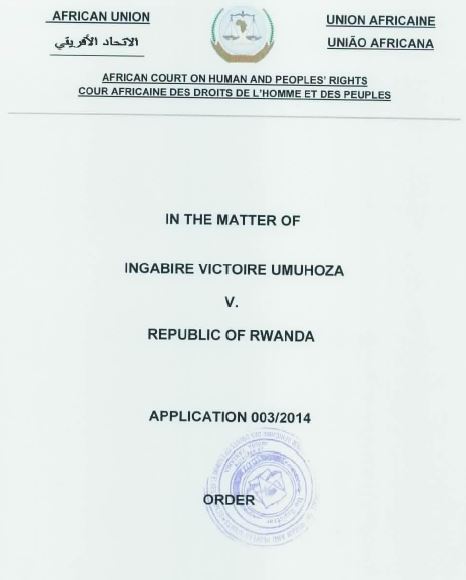Note: The following is a review of 2015 at the African Court that first appeared as a guest post on Opinio Juris on 19 January 2016 here. If you have already read the Opinio Juris piece then there will be nothing new here, but I post it for our subscribers and those who maybe missed it on Opinio Juris.
Following some positive feedback from last year’s Opinio Juris guest post rounding up the activities of the African Court on Human and Peoples’ Rights in 2014, subsequently cross-posted here at the Monitor, I thought a review of some of the Court’s key 2015 events may be of interest.
For those who are not familiar with the Court, it was established by the African Union (AU) to hear cases relating to alleged violations of the African Charter on Human and Peoples’ Rights (African Charter) and other international human rights instruments. The Court is based in Arusha, Tanzania and is separate to its cousin the African Commission on Human and Peoples Rights. Two key instruments to keep in mind are the Court’s Protocol, ratification of which gives the Court jurisdiction to hear cases referred to it by the African Commission, from the country itself, from other AU members states and from African Intergovernmental Organizations. The other instrument is the “Special Declaration”, found in Article 5 (3) and Article 34 (6) of the Protocol, which must be signed by the member state in addition to the Protocol to allow individuals and NGOs from that member state to petition the Court directly.
May: the Court’s 37th Ordinary Session
At its 37th Ordinary Session the Court held public hearings in two cases concerning Tanzania. In Onyango et al v Tanzania the Applicants, all citizens of Kenya, allege they were kidnapped in Mozambique and taken to Tanzania where they were charged with murder and three charges of armed robbery. In Abubakari v Tanzania, the Applicant challenges a conviction and 30 year sentence for two counts of armed robbery. Judgement in both cases is pending.
June: Zongo and others v Burkina Faso reparations judgement
Having handed down judgment on the merits in March 2014 in Zongo and others v Burkina Faso, in which the Court found that with regards to the alleged assassination of investigative journalist Norbert Zongo and colleagues in December 1998, Burkina Faso violated several articles of the African Charter and Article 66 of the ECOWAS Treaty by failing to take measures to ensure the families of the deceased the right to be heard by a competent national court, the Court handed down its judgement on reparations. This judgement is the first in which the Court has awarded reparations to successful applicants. The judgement solidified the Court’s initial findings in June 2014 in the Mtikila v Tanzania reparations judgement that the Court has the power to award reparations to the victims of human rights violations. Zongo builds on this by actually doing so. In fact, the Court awarded the entire amount claimed in reparations by the applicants who consisted of the spouses, children and parents of the deceased. The Court also awarded a symbolic payment to the NGO who assisted in bringing the case and ordered costs for lawyer’s fees, travel and accommodation. As I have written elsewhere, the award of reparation should cement Zongo and others v Burkina Faso as another landmark case for the Court.
July: sensitization visit to Lesotho
In July, the Court conducted a one-day sensitization visit to Lesotho. The main objective of sensitization visits being to enhance the protection of human rights in Africa and promote the Court and its activities. As the Court’s press release explained, Court officials met with various government officials, lawyers and NGOs. The visit saw further promises from both government and the NGO sector to work toward signing the Court’s Special Declaration that would individuals and NGOs in Lesotho direct access to the Court.
July: the EACJ ruled on the Court’s Special Declaration
In Democratic Party v Secretary General of the East African Community and others the Appellate Division of the East African Court of Justice (EACJ) ruled on whether signing the Court’s Protocol also creates an obligation on the member state to sign the Special Declaration. The EACJ Appellate Division found that whilst it was able to consider potential violations of the African Charter and the Court’s Protocol under the premise of the East African Community Treaty, the wording of Article 5 (3) and Article 34 (6) of the Protocol contained no requirement that a member state who signs the Protocol must also sign the Special Declaration. This important decision seems to preclude, at least for now, reading any obligations into signing the Protocol that are not clearly spelled out, and keeps the process for granting individuals and NGOs access to the Court a definite two stage process.
August: Cameroon ratifies the Court’s Protocol
In August, Cameroon ratified the Court’s Protocol, taking the number of AU member states who have ratified to 29. Still, only seven AU member states have signed the additional Special Declaration. The AU has a total of 54 members.
September: (Then) President Kikwete visits the Court
Tanzanian President Kikwete, as he was prior to Tanzania’s elections, visited the Court in September. During this visit Kikwete announced that Tanzania was pledging $100,000 towards the Court’s legal aid scheme, which was set up in July 2014. Sadly, some 14 months after the fund’s creation, Tanzania’s pledge appears to be the first and only such donation to the legal aid scheme to date.
October: sensitization visit to South Africa
The Court held a one-day sensitization event in South Africa, including an address by the Court’s President Justice Ramadhani encouraging South Africa, which ratified the Court’s protocol some 13 years ago, to make the Special Declaration. More information on the visit can be seen here and here.
November: 39th Ordinary Session
The Court rendered its judgement on the merits in Thomas v Tanzania at its 39th Ordinary Session, marking another success for an applicant before the Court, this time relating to fair trial rights.
The Applicant was convicted in Tanzania of armed robbery and sentenced to thirty years imprisonment, a sentence he was serving at the time of the application. The Court found that the trial process leading to the Applicant’s conviction and his subsequent attempts to appeal said conviction were riddled with violations of his right to a fair trial. In particular, the Court found Tanzania in violation of Articles 1, 7(1) (a) (The right to an appeal to competent national organs) , (c) (the right to a defence and counsel of choice), and (d) (The right to be tried within a reasonable time by an impartial court or tribunal) of the African Charter as well as Article 14(3)(d) of the ICCPR. However, despite finding these violations, the Court rejected his request for immediate release from prison, since he had not set out “specific or compelling circumstances”. Instead, it called on Tanzania to remedy the violations within six months, specifically precluding retrial or the reopening of the defence case as remedies, given that the Applicant had served 20 out of 30 years in prison; surely an indirect call by the Court for the Applicant to be released. Issues of costs and reparations have been postponed to a later date.
November: 2nd Judicial Dialogue
The Court jointly organized with the AU the second “Continental Judicial Dialogue” which took place in Arusha. The event included delegates from AU member states, including Chief Justices, Presidents of Supreme Courts and Constitutional Courts, members of academia, national judiciaries and media. The theme of the three day event was “Connecting National and International Justice”. Interestingly, amongst the attendees were a number of judge from the Inter-American Court of Human Rights who shared their experiences of sitting on human rights cases.
December: sensitization visit to Chad and the results of the Court’s inaugural moot court competition
The Court undertook its third sensitization visit of the year to Chad. From this visit, we received the encouraging promise that Chad will sign the Court’s Protocol and, crucially for access issues, the Special Declaration. Although at the time of writing this has not yet happened, the public declaration will hopefully serve to see Chad go on to fulfil its promise sooner rather than later.
Finally, the Court announced the winners of its inaugural moot court competition, with Moi University in first place, the University of Zambia a close second and Makerere University third.
Conclusion
The Court continued to promote itself with sensizitation visits AU to Leshoto, South Africa and Chad, with this last visit resulting in the promise that Chad will sign the Court’s Protocol and Special Declaration imminently. Whilst there were also rumblings in Uganda about signing the Special Declaration, it is worth noting that no AU member state actually signed the Special Declaration in 2015, meaning further engagement with member states is clearly needed. On actual cases before the Court, applicants continue have a 100% success rate, having now gone a perfect 4-for-4 before the Court, showing that when jurisdictional issues are overcome the Court is not afraid to make findings against member states.
Above all, 2015 felt like a year in which the Court continued to mature and begin to seriously promote itself across Africa. The President of Court himself has been vocal in urging AU members states to sign the Protocol and Special Declaration allowing individuals and NGOs direct access to the Court as can be seen here, here, here, and here. Of course, what continues to hamper the Court is the number of individuals and NGOs who can actually access the Court. To make the Court a truly continental one, AU member states must sign up and embrace the Court in 2016 and beyond.
Reminder: The views expressed herein are those of the author alone and do not necessarily reflect the views of any organisation affiliated to the author.

 Junior Editor of The Monitor.
Junior Editor of The Monitor. 